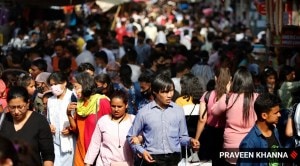- India
- International
At Asia’s largest abattoir, butchers fear livelihood loss as beef ban sets in
Maharashtra’s beef trade is controlled by Muslims of Qureshi community, who work as butchers and dealers.
 The BMC that manages the abattoir is losing about Rs 80,000 per day in the form of slaughtering and entry fees. (Source: IE photo by Vasant Prabhu)
The BMC that manages the abattoir is losing about Rs 80,000 per day in the form of slaughtering and entry fees. (Source: IE photo by Vasant Prabhu)
At 64 acres, the Deonar abattoir in Mumbai’s central suburbs is one of Asia’s largest slaughterhouses. These days though, the wooden slabs on which till recently were culled bulls, bullocks and buffaloes are used as sleeping spaces by the its daily labourers. Some distance away, another group of butchers is playing cards, while a third group discusses their strained finances in the absence of daily earnings of Rs 300.
Six buffaloes are tethered to an iron ring, but these and the now-faint rancid smell are the only remnants of the bustling beef trade at Deonar. A hundred metres away, the milling goats, pigs and chickens tell a different story.
The cattle yard has had no work since March 5. On March 2, President Pranab Mukherjee’s assent to a 19-year-old Maharashtra Bill banned the slaughter of bulls and bullocks in the state, in addition to the cow slaughter ban in place since 1976. On March 4, dealers in Deonar stopped buying and slaughtering any large animals, including water buffaloes on which there is no ban, as a sign of protest.
[related-post]
The meat of bull and bullock comprised 75 per cent of the beef market. What remains is carabeef, or buffalo meat. Seen as an inferior meat, carabeef was the only kind allowed to be exported, and hence fetched a slightly higher price (Rs 200 per kg) than bull or bullock meat (Rs 160/ kg).
Dr Keshav Narsapurkar, a retired veterinarian who works at the abattoir as a consultant, says 298 bullocks were removed from the compound on March 4 as news trickled in of the new law. “But police seized some at the Karnataka border. No new cattle has been brought to Deonar since then.”

Till March 4, 450 bulls, bullocks and buffaloes were slaughtered daily on an average at the abattoir.
Maharashtra’s beef trade is controlled largely by Muslims of the Qureshi community, who work as butchers, agents and dealers. But Hindu farmers from across the state and neighbouring Madhya Pradesh, Rajasthan, Karnataka and Andhra Pradesh were among those who sold their old and infirm cattle at the abattoir.
“Saalon se hum mazdoor the, ab majboor ban gaye (For years, we have been labourers. Now we are helpless),” laments Salim Qureshi, a 62-year-old butcher. He has been working at the abattoir for 40 years, joined there by his four sons. Their joint family of 24, living in Qureshi Mohalla, survives on their earnings. The mohalla, a slum, is situated next to the abattoir and abuts the Govandi railway station.
Apart from the Qureshis, Dalit families working in the abattoir as caretakers of the cattle stay at the mohalla.
“For 16 days, we have not received any money. The worst thing is we are unsure if we will have jobs in the coming months too,” says Junaid Qureshi, 27, Salim’s youngest son.
As only buffaloes can now be culled at the abattoir, money and wages will shrink. The mutton industry at Deonar has its own butchers and dealers.
“We used to feed the cattle and keep them cool. What are we to do?” says Shashikant Vapule, 44, a cattle caretaker.
The 900 licensed beef dealers at Deonar peg their collective losses at Rs 1.2 crore daily. The BMC that manages the abattoir is losing about Rs 80,000 per day in the form of slaughtering and entry fees.
Meanwhile, prices of carabeef are expected to skyrocket. “The three sectors competing for buffaloes will be those slaughtering for export, the dairy industry and beef shop owners. Can you imagine the prices and shortage then?” says Mohamed Qureshi, president of the Mumbai Suburban Beef Dealer Association.
The prices of other meat are already rising. Sharif Sarvar, a goat trader, says that mutton is Rs 420 to Rs 440 a kg, up from Rs 380 a kg. However, even he isn’t too happy. “Customers won’t spend so much to buy mutton,” he worries.
Industries that utilise the hide, blood, horns and entrails of the slaughtered cattle are also hit. Those buying infirm cattle from farmers for popular tanneries such as Farida Group, K H Group and TAW say Maharashtra is responsible for up to 65 per cent of the raw material for Tamil Nadu’s leather industry.
Zakhir Hussain, who shuttles fortnightly between Mumbai and Chennai, says the ban will significantly dent the leather industry. “There are eight grades of leather, and Maharashtra generates the high-grade kind,” he says.
Says Vijay Dalvi, secretary of the Sarv Shramik Sangh, “This ban affects tanneries, cosmetics industries, meat packaging industry, and those utilising animal products for research and medicine. We won’t go down without a fight.”
Azghar Saad, who works as an agent purchasing animals from farmers, pegs the number of people involved in work arising from the slaughter of one “certified-for-slaughter” animal at 1,000. “Farmers will never sell a milch cow but now they don’t know what to do with a dying one,” he adds.
Must Read
Apr 19: Latest News
- 01
- 02
- 03
- 04
- 05






































